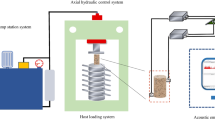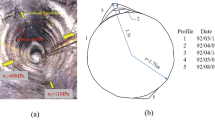Abstract
Water films probably form beneath less-permeable interlayers in liquefiable deposits during an earthquake, further resulting in devastating disasters. However, the development of such water film and its effect on the liquefaction behavior of stratified deposits are still unclear. Herein, a water sedimentation method was developed in laboratory to reproduce the layered structure of sandy soil deposited in water during land reclamation. Undrained cyclic torsional shear tests were conducted to visualize the evolution of localized liquefaction behavior incorporating an image-based measurement technique. The test results indicate that the liquefaction resistance of layered specimens with less-permeable fine layers was similar to that of specimens without fine layer, which was possibly due to the lower liquefaction resistance of the sand layer compared to the fine layer. Large local strains periodically observed at the bottom of fine layer during undrained cyclic shearing implied that pore water concentrated into thin zones, which was also directly proven by the differential pore pressures in the sand and fine layers within the layered specimen. Moreover, large local strains also manifested a relatively lower liquefaction resistance of specimen compared to that evaluated by global strains. As specimen was closely liquefied, a hydraulic gradient significantly higher than its critical value to drive upward particle migration was formed at the fine layer, which overcomes the resultant force of gravity and buoyancy acting on soil particle. This hydraulic gradient and the less-permeable fine layer provided the formation conditions of a subjacent water film.
























Similar content being viewed by others
Abbreviations
- \({G}_{s}\) :
-
Specific gravity
- \({D}_{50}\) :
-
Mean diameter of Katori sand
- \({D}_{10}\) :
-
10% Of the particles finer than this size
- \({e}_{max}\) :
-
Maximum void ratio
- \({e}_{min}\) :
-
Minimum void ratio
- H :
-
Height of specimen
- \({D}_{i}\) :
-
Inner diameter of hollow cylindrical specimen
- \({D}_{o}\) :
-
Outer diameter of hollow cylindrical specimen
- \({\rho }_{{d}_{overall}}\) :
-
Overall dry density
- \({e}_{overall}\) :
-
Overall void ratio
- \({D}_{{r}_{overall}}\) :
-
Overall relative density
- \({R}_{i}\) :
-
Inner radius of hollow cylindrical specimen
- \({R}_{o}\) :
-
Outer radius of hollow cylindrical specimen
- \({F}_{c}\) :
-
Fine content
- \(\upgamma\) :
-
Shear strain
- \(\uptau\) :
-
Shear stress
- \({\tau }_{d}\) :
-
Amplitude of shear stress
- \(p_{o}^{\prime }\) :
-
Initial effective mean principal stress
- \({p}^{^{\prime}}\) :
-
Effective mean principal stress
- \(\Delta u\) :
-
Excess pore water pressure
- \(\Delta {u}_{d}\) :
-
Differential excess pore water pressure
- \({u}_{sand}\) :
-
Pore water pressure in sand layer
- \({u}_{fines}\) :
-
Pore water pressure in fine layer
- \(\theta\) :
-
Rotation angle of specimen top cap
- \({T}_{t}\) :
-
Torque measured by load cell
- \({T}_{m}\) :
-
Torque applied to the membrane
- T :
-
Torque effectively applied to the specimen
- \({t}_{m}\) :
-
Thickness of membrane
- \({E}_{m}\) :
-
Young’s modulus of membrane
- \({i}_{c}\) :
-
Critical hydraulic gradient
- n :
-
Porosity
- \({\gamma }_{w}\) :
-
Specific gravity of water
References
Amini F, Qi G (2000) Liquefaction testing of stratified silty sands. J Geotech Geoenviron Eng 126(3):208–217
Ampadu S, Tatsuoka F (1993) Effect of setting method on the behaviour of clays in triaxial compression from saturation to undrained shear. Soils Found 33(2):14–34
Bhandari A, Powrie W, Harkness R (2012) A digital image-based deformation measurement system for triaxial tests. Geotech Test J 35(2):209–226
Bhattacharya S, Hyodo M, Goda K, Tazoh T, Taylor C (2011) Liquefaction of soil in the Tokyo Bay area from the 2011 Tohoku (Japan) earthquake. Soil Dynam Earthq Eng 31(11):1618–1628
Chu DB, Stewart JP, Youd TL, Chu B (2006) Liquefaction-induced lateral spreading in near-fault regions during the 1999 Chi-Chi, Taiwan earthquake. J Geotech Geoenviron Eng 132(12):1549–1565
Elgamal A-W, Zeghal M, Parra E (1996) Liquefaction of reclaimed island in Kobe. Jpn J Geotech Eng 122(1):39–49
Fauzi UJ (2015) Local deformation and repeated liquefaction properties of segregated sand specimen in hollow cylindrical torsional shear tests. Dissertation, The University of Tokyo
Fauzi UJ (2014) Koseki J (2014) Local deformation properties of segregated sand specimen in hollow cylindrical torsional shear tests. Bull ERS 47:27–36
Fiegel GL, Kutter BL (1994) Liquefaction mechanism for layered soils. J Geotech Eng 120(4):737–755
Group RLGR (2016) Ground failures on reclaimed land during the 2011 Tohoku earthquake: a case study in Urayasu City. Jpn Quat Int 387(2016):555–562
Harris WW, Viggiani G, Mooney MA, Finno RJ (1995) Use of stereophotogrammetry to analyze the development of shear bands in sand. Geotech Test J 18(4):405–420
Ishihara K (1993) Liquefaction and flow failure during earthquakes. Geotechnique 43(3):351–451
JGS (2009a) Laboratory testing standards of geomaterials: test method for particle size distribution of soils. JGS 0131-2009. Tokyo, Japan: The Japanese Geotechnical Society
JGS (2009b) Laboratory testing standards of geomaterials: test method for minimum and maximum densities of sands. JGS 0161-2009. Tokyo, Japan: The Japanese Geotechnical Society
Kokusho T (1999) Water film in liquefied sand and its effect on lateral spread. J Geotech Geoenviron Eng 125(10):817–826
Kokusho T (2000) Mechanism for water film generation and lateral flow in liquefied sand layer. Soils Found 40(5):99–111
Kokusho T (2003) Current state of research on flow failure considering void redistribution in liquefied deposits. Soil Dynam Earthq Eng 23(7):585–603
Kokusho T, Kojima T (2002) Mechanism for postliquefaction water film generation in layered sand. J Geotech Geoenviron Eng 128(2):129–137
Koseki J, Yoshida T, Sato T (2005) Liquefaction properties of Toyoura sand in cyclic tortional shear tests under low confining stress. Soils Found 45(5):103–113
Kulasingam R, Malvick EJ, Boulanger RW, Kutter BL (2004) Strength loss and localization at silt interlayers in slopes of liquefied sand. J Geotech Geoenviron Eng 130(11):1192–1202
Li L, Li P, Cai Y, Lu Y (2021) Visualization of non-uniform soil deformation during triaxial testing. Acta Geotech 16(11):3439–3454
Li L, Lu Y, Cai Y, Li P (2021) A calibration technique to improve accuracy of the photogrammetry-based deformation measurement method for triaxial testing. Acta Geotech 16(4):1053–1060
Liang Y, Yeh T-CJ, Zha Y, Wang J, Liu M, Hao Y (2017) Onset of suffusion in gap-graded soils under upward seepage. Soils Found 57(5):849–860
Lin H, Penumadu D (2006) Strain localization in combined axial-torsional testing on kaolin clay. J Eng Mech 132(5):555–564
Macari EJ, Parker JK, Costes NC (1997) Measurement of volume changes in triaxial tests using digital imaging techniques. Geotech Test J 20(1):103–109
Maharjan M, Takahashi A (2013) Centrifuge model tests on liquefaction-induced settlement and pore water migration in non-homogeneous soil deposits. Soil Dynam Earthq Eng 55(2013):161–169
Maharjan M, Takahashi A (2014) Liquefaction-induced deformation of earthen embankments on non-homogeneous soil deposits under sequential ground motions. Soil Dynam Earthq Eng 66(66):113–124
Malvick EJ, Kutter BL, Boulanger RW (2008) Postshaking shear strain localization in a centrifuge model of a saturated sand slope. J Geotech Geoenviron Eng 134(2):164–174
Matlab (2013) Matrix laboratory: version R2013b. The MathWorks Inc., USA
Oda M, Kawamoto K, Suzuki K, Fujimori H, Sato M (2001) Microstructural interpretation on reliquefaction of saturated granular soils under cyclic loading. J Geotech Geoenviron Eng 127(5):416–423
Orense R, Pender M, Wotherspoon L (2012) Analysis of soil liquefaction during the recent Canterbury (New Zealand) earthquakes. Geotech J SEGAS AGSSEA 43(2):8–17
Pradel D, Wartman J, Tiwari B (2014) Impact of anthropogenic changes on liquefaction along the Tone River during the 2011 Tohoku Earthquake. Nat Hazards Rev 15(1):13–26
Seed HB (1987) Design problems in soil liquefaction. J Geotech Eng 113(8):827–845
Shao LT, Liu G, Zeng FT, Guo XX (2016) Recognition of the stress-strain curve based on the local deformation measurement of soil specimens in the triaxial test. Geotech Test J 39(4):658–672
Sukkarak R, Tanapalungkorn W, Likitlersuang S, Ueda K (2021) Liquefaction analysis of sandy soil during strong earthquake in Northern Thailand. Soils Found 61(5):1302–1318
Tanaka Y (2000) The 1995 great Hanshin Earthquake and liquefaction damages at reclaimed lands in Kobe Port. Int J Offshore Polar Eng 10(01):1–9
Terzaghi K (1929) Effect of minor geologic details on the safety of dams. Amer Inst Min Met Engrs 215:31–44
Towhata I, Maruyama S, Kasuda K-i, Koseki J, Wakamatsu K, Kiku H, Kiyota T, Yasuda S, Taguchi Y, Aoyama S, Hayashida T (2014) Liquefaction in the Kanto region during the 2011 off the pacific coast of Tohoku earthquake. Soils Found 54(4):859–873
Towhata I, Orense RP, Toyota H (1999) Mathematical principles in prediction of lateral ground displacement induced by seismic liquefaction. Soils Found 39(2):1–19
Toyota H, Towhata I, Imamura S-I, Kudo K-I (2004) Shaking table tests on flow dynamics in liquefied slope. Soils Found 44(5):67–84
Tsukamoto Y, Kawabe S, Kokusho T (2012) Soil liquefaction observed at the lower stream of Tonegawa river during the 2011 off the Pacific Coast of Tohoku Earthquake. Soils Found 52(5):987–999
White D, Take W, Bolton M (2003) Soil deformation measurement using particle image velocimetry (PIV) and photogrammetry. Geotechnique 53(7):619–631
Yasuda S, Harada K, Ishikawa K, Kanemaru Y (2012) Characteristics of liquefaction in Tokyo Bay area by the 2011 Great East Japan Earthquake. Soils Found 52(5):793–810
Yoshimine M, Koike R (2005) liquefaction of clean sand with stratified structure due to segregation of particle size. Soils Found 45(4):89–98
Zhang X, Li L, Chen G, Lytton R (2015) A photogrammetry-based method to measure total and local volume changes of unsaturated soils during triaxial testing. Acta Geotech 10(1):55–82
Zhao C, Koseki J (2020) An image-based method for evaluating local deformations of saturated sand in undrained torsional shear tests. Soils Found 60(3):608–620
Zhao C, Koseki J, Liu W (2019) Local deformation behaviour of saturated silica sand during undrained cyclic torsional shear tests using image analysis. Géotechnique 70(7):621–629
Zhao C, Koseki J, Sasaki T (2018) Image based local deformation measurement of saturated sand specimen in undrained cyclic triaxial tests. Soils Found 58(6):1313–1325
Acknowledgements
The authors express their highest appreciation to Prof. Junichi Koseki, Mr. Takeshi Sato and Dr. Yukika Miyashita, Institute of Industrial Science, University of Tokyo for their guidance and assistances. This work was supported by National Natural Science Foundation of China (No. 52008369), China Postdoctoral Science Foundation (Grant No. 2019M662057) and Chinese Program of Introducing Talents of Discipline to University (the 111 Project, B18047).
Author information
Authors and Affiliations
Corresponding author
Additional information
Publisher's Note
Springer Nature remains neutral with regard to jurisdictional claims in published maps and institutional affiliations.
Rights and permissions
About this article
Cite this article
Zhao, C., Fauzi, U.J. Visualized liquefaction behavior of sandy soil deposited in water under undrained cyclic shearing. Acta Geotech. 17, 3143–3160 (2022). https://doi.org/10.1007/s11440-022-01508-6
Received:
Accepted:
Published:
Issue Date:
DOI: https://doi.org/10.1007/s11440-022-01508-6




